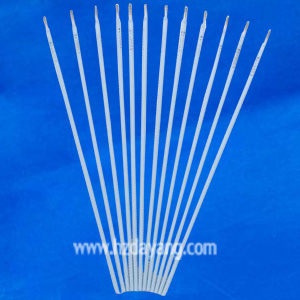| Replay: Welding electrodes, surfacing is generally based on the requirements in the selection of different alloy systems and different hardness rating electrode of. Introduction to welding electrode wear
Surfacing Welding layer of special alloy surface in any part of the workpiece, and Its purpose is to improve the face of resistance to wear, corrosion and heat-resistant performance, in order to reduce costs, to improve the overall performance and service life, this The function of the electrode for welding electrode wear, also known as the surfacing electrode. The surfacing also commonly used in the repair normalized utilizing waste.
Edit this paragraph melt composition of deposited metal and hardness
Welding electrode wear metal ingredients%: C 1.5 Cr ≤ 3.00 Ni ≤ 5.00-7.00 Si ≤ 1.00 W ≤ 70-85 electrode with tungsten carbide transition the surfacing metal containing tungsten 65% -85% surfacing hardness HRC ≥ 70.
Edit this section perform GB
Perform GB984-85 standard
Edit this paragraph range of applications
Mainly used in chemical equipment and machinery and equipment wear parts surfacing repair. Reamer as slag crusher wearing parts (such as hammer crusher, hammer plate, counter plate), cement kiln unloading equipment (trays, spire, tower grate), brick-making machine, mixer blades, dredger blades, power plants, wind turbine blades, steel mill blast furnace chute linings, roller cone break, charcoal.
Edit this paragraph surfacing cracking problem-solving method
The most common problems encountered in surfacing cracking, to prevent cracking of the main methods: 1, preheat control interpass temperature, slow cooling after welding. 2, post-weld stress relief heat treatment. 3, to avoid the multi-layer surfacing cracking, low hydrogen type surfacing electrode. 4, when necessary, between the overlay and the base material surfacing buffer layer (with a low carbon equivalent, the high toughness of the electrode). Cracking with the workpiece and the deposited weld metal carbon content, alloying elements, there is a direct relationship between the preheat temperature is generally based on the the electrode carbon equivalent to estimate. Carbon equivalent formula is as follows: Ceq = C 1/6Mn 1/24Si 1/5Cr 1/4Mo 1/15Ni estimation formula suitable for low, medium and high carbon and low-alloy steel. Carbon equivalent (%) preheating temperature of preheating temperature of carbon equivalent (%) ≤ 0.40 100 ℃ ≤ 0.70 250 ℃ ≤ 0.50 of 150 ° C ≤ 0.80 300 ℃ ≤ 0.60 200 ℃ ≤ 0.90 350 ℃ high manganese steel austenitic stainless steel, do not preheat. High alloy steel, the preheating temperature is higher than 400 ° C. Surfacing effect refers solder layer hardness, wear-resistant and heat-resistant properties, the performance level of the following factors: 1. Welding current size, the length of the arc. The current is large, the length of the arc, alloying elements easy burnout, Conversely, the beneficial alloying elements transition. 2. Preheat temperature, slow cooling conditions to determine the quality of the surfacing layer. Some surfacing metal with different heat treatment methods can be different hardness. Hardness and chemical composition of the surfacing layer refers to the surfacing metal surfacing of more than three. |












